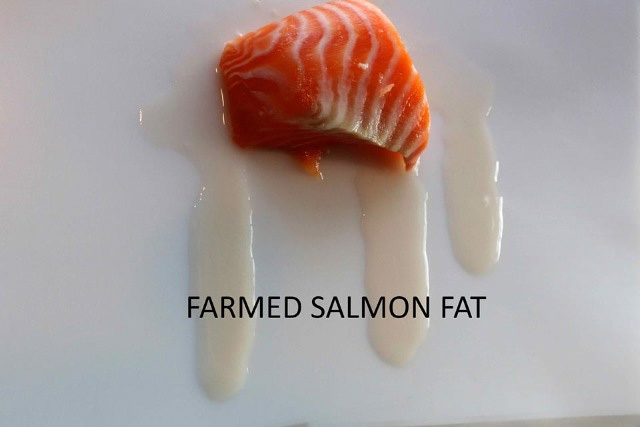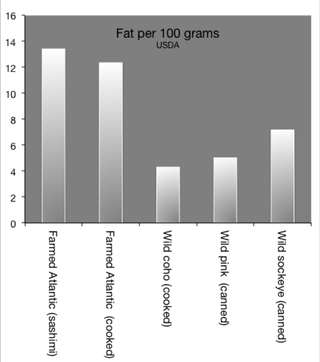FATTY = TOXIC
 To examine just how much fat is in farmed salmon we had a salmon fat cook off and then put the squeeze on farmed salmon. The fat content is astonishing! PCBs and dioxins have been detected in farmed salmon fat which is why doctors warn – women and children should avoid farmed salmon.
To examine just how much fat is in farmed salmon we had a salmon fat cook off and then put the squeeze on farmed salmon. The fat content is astonishing! PCBs and dioxins have been detected in farmed salmon fat which is why doctors warn – women and children should avoid farmed salmon.
I do not recommend pregnant women, children or young people eat farmed salmon. It is uncertain in both the amount of toxins salmon contain, and how these drugs affect children, adolescents and pregnant women… The type of contaminants that have been detected in farmed salmon have a negative effect on brain development and is associated with autism, ADD / ADHD and reduced IQ. We also know that they can affect other organ systems in the body’s immune system and metabolism.
Dr. Anne-lise Bjorke Monsen, University of Bergen, Norway
HIGHER FAT CONTENT
 Farmed salmon has much higher fat content than wild salmon, because they are fed a high-fat diet designed to make them gain weight as fast as possible. Farmed salmon eat pellets made of fish meal and grains that are soaked in fish oils. This graph shows some of the data on fat in farmed vs wild salmon.
Farmed salmon has much higher fat content than wild salmon, because they are fed a high-fat diet designed to make them gain weight as fast as possible. Farmed salmon eat pellets made of fish meal and grains that are soaked in fish oils. This graph shows some of the data on fat in farmed vs wild salmon.
(data source: USDA )
WHY FARMED SALMON IS SO CONTAMINATED

- PCBs and dioxins exist throughout the food chain. Farmed salmon eat pellets made of fish meal and grains that are soaked in fish oils. Since these toxins bind to fat, the oils in farmed salmon feed can contribute considerable toxin loads. Wild salmon do not eat rendered fish oils and so do not get this extra exposure;
- The second source of toxins in farmed salmon is the grain used to replace fish meal which is becoming too expensive as it becomes scarce. Endosulfan is a pesticide that many countries stopped using when the Stockholm Convention recommended a worldwide ban in 2010 due to its nasty impact on human health. Farm salmon feed companies, however, can buy grains from countries that are ignoring this ban. Perhaps this grain is cheaper. While Norway is a forward-thinking nation in some ways, in 2013 they actually lobbied the European Union to allow 10 times more endosulfan in farmed salmon feed. It appears from the EU decision document that this was done to make farmed salmon feed cheaper and salmon farming more profitable. ((EU Report: see section 6)
